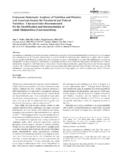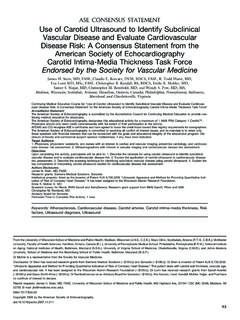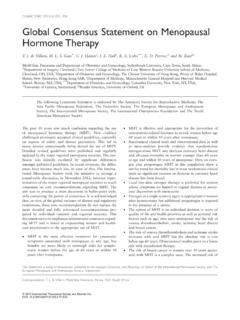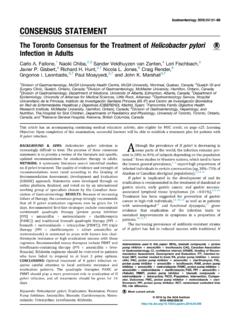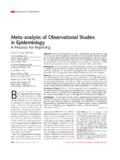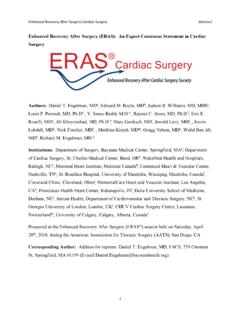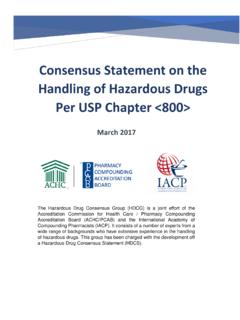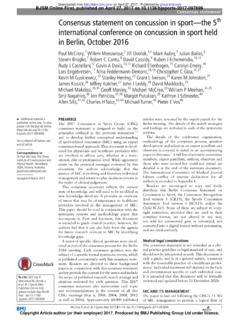Transcription of ASPEN & AND 2012 Consensus Statement …
1 Journal of Parenteral and Enteral NutritionVolume 36 Number 3 May 2012 275-283 2012 American Society for Parenteral and Enteral Nutrition and the Academy of Nutrition and DieteticsDOI: StatementMalnutrition is most simply defined as any nutrition People suffer from overnutrition when they consume too many calories. Although the focus of this Consensus Statement is adult undernutrition, we cannot fail to recognize the enormous impact that obesity has on both personal and national health and rising healthcare Even overweight or obese adults who develop a severe acute illness or experience a major trau-matic event are at risk for malnutrition and frequently need and benefit from intensive nutrition adults who lack adequate calories, protein, or other nutrients needed for tissue maintenance and repair experience undernutrition. In acute, chronic, and transitional care settings, recognition and treatment of adult undernutrition are a primary ,7-10 For the purposes of this discussion, therefore, the term adult malnutrition shall be synonymous with adult undernutrition typically occurs along a continuum of inadequate intake and/or increased requirements, impaired absorption, altered transport, and altered nutrient utilization.
2 Weight loss can and frequently does occur at multiple points along this continuum. Individuals may also present with inflam-matory, hypermetabolic, and/or hypercatabolic conditions. Inflammation is increasingly identified as an important under-lying factor that increases the risk for malnutrition and may contribute to suboptimal response to nutrition intervention and increased risk of As such, individuals may exhibit a wide range of characteristics from severe malnutrition to those with nonsevere (mild to moderate) malnutrition that, if left unrecognized and unaddressed, is likely to progress to a severely malnourished Although various laboratory tests and physical signs or symptoms have been suggested as potential markers for inflammation, and some are briefly men-tioned in passing in this document, the Academy of Nutrition and Dietetics (Academy) and the American Society for Parenteral and Enteral Nutrition ( )
3 Do not propose any specific inflammatory markers for diagnostic purposes at this is a major contributor to increased morbidity and mortality, decreased function and quality of life, increased frequency and length of hospital stay, and higher healthcare Statement / White et alJournal of Parenteral and Enteral Nutrition2012 From the 1 University of Tennessee, Knoxville, Tennessee; , Silver Spring, MD; 3 The Pennsylvania State University, University Park, Pennsylvania; 4Mt. Carmel West Hospital, Columbus, Ohio; and 5 Academy of Nutrition and Dietetics, Chicago, disclosure: none article is simultaneously published in the May 2012 issues of the Journal of Parenteral and Enteral Nutrition and the Journal of the Academy of Nutrition and Author: Jane V. White, PhD, RD, FADA, Department of Family Medicine, 1924 Alcoa Hwy, Knoxville TN 37920; e-mail: to the podcast for this article and other JPEN podcasts at Statement : Academy of Nutrition and Dietetics and American Society for Parenteral and Enteral Nutrition: Characteristics Recommended for the Identification and Documentation of Adult Malnutrition (Undernutrition)Jane V.
4 White, PhD, RD, FADA1; Peggi Guenter, PhD, RN2; Gordon Jensen, MD, PhD, FASPEN3; Ainsley Malone, MS, RD, CNSC4; Marsha Schofield, MS, RD5; the Academy Malnutrition Work Group; the Malnutrition Task Force; and the Board of DirectorsAbstractThe Academy of Nutrition and Dietetics (Academy) and the American Society for Parenteral and Enteral Nutrition ( ) recommend that a standardized set of diagnostic characteristics be used to identify and document adult malnutrition in routine clinical practice. An etiologically based diagnostic nomenclature that incorporates a current understanding of the role of the inflammatory response on malnutrition s incidence, progression, and resolution is proposed. Universal use of a single set of diagnostic characteristics will facilitate malnutrition s recognition, contribute to more valid estimates of its prevalence and incidence, guide interventions, and influence expected outcomes.
5 This standardized approach will also help to more accurately predict the human and financial burdens and costs associated with malnutrition s prevention and treatment and further ensure the provision of high-quality, cost-effective nutrition care. (JPEN J Parenter Enteral Nutr. 2012;36:275-283)Keywords adult; inflammation; nutrition assessment by guest on September 25, from 276 Journal of Parenteral and Enteral Nutrition 36(3) ,7-11 Jensen et al8 propose an overarching definition of malnutrition as decline in lean body mass with the potential for functional impairment at multiple levels (ie, molecular, physiologic, and/or gross motor). The diagnosis of malnutri-tion in a patient is an undeniably complicating condition that in many cases significantly increases resource utilization in the acute care setting beyond that experienced by the patient in nutrition purpose is to define malnutrition for adults in all set-tings.
6 In the absence of data showing that malnutrition should be defined differently in different settings, the Academy and have adopted patient-specific definitions based on etiologies including social and environmental circumstances, chronic illness, and acute illness. The distinction between acute and chronic illness is based on time (the National Center for Health Statistics [NCHS] defines chronic as a disease or condition that lasts 3 months or longer).12 The Academy and propose etiologic-based definitions that consider time and degree of inflammatory response in categorizing an illness or injury as acute vs to Standardize Characteristics to Diagnose and Document Adult MalnutritionAdult malnutrition is a common but frequently unrecognized problem whose incidence and prevalence are difficult to In 1996, The Joint Commission mandated that nutrition screening be accomplished within 24 hours of This resulted in the identification of multiple criteria and the development of a number of different approaches to the iden-tification of malnutrition in hospitalized patients that were not always evidence Thus, there is currently no single, universally accepted approach to the diagnosis and documen-tation of adult malnutrition.
7 Current estimates of the preva-lence of adult malnutrition range from 15% 60% depending on the patient population and criteria used to identify its Diagnostic elements in malnutrition screening proto-cols vary widely and range from a simple assessment of appetite and unintentional weight loss14 to more complex protocols that include measurement of a variety of anthropo-metric and laboratory number of the more complex protocols that have been developed to detect malnutrition in adults rely on changes in acute phase proteins such as serum albumin and prealbumin as primary diagnostic indicators of adult The Academy of Nutrition and Dietetics Evidence Analysis Library (EAL) analyzed reduction and/or change in serum albumin and prealbumin with weight loss in prolonged pro-tein energy restriction, anorexia nervosa, non-malabsorptive gastric partitioning bariatric surgery, calorie-restricted diets, starvation, low-calorie diets, and nitrogen The analysis indicated that these acute phase proteins do not con-sistently or predictably change with weight loss, calorie restriction, or nitrogen They appear to better reflect severity of the inflammatory response rather than poor nutrition These laboratory tests, although probable indicators of inflammation, do not specifically indicate mal-nutrition and do not typically respond to feeding interven-tions in the setting of active inflammatory Thus, the relevance of laboratory tests of acute phase protein levels, as indicators of malnutrition, is 2007.
8 The Centers for Medicare & Medicaid Services (CMS) resequenced its prospective payment system (the Diagnostic-Related Groups) into a hierarchical system called the Medicare Severity Diagnostic-Related Groups (MS-DRGs) that reflects the presence or absence of complications and/or The MS-DRGs are payment groups designed for the Medicare population. Patients with similar clinical char-acteristics and similar costs are assigned to an MS-DRG that is linked to a fixed payment amount based on the average cost of care for patients in the group. Since the designation of malnu-trition as an MS-DRG, CMS has voiced concern about the inappropriate use of certain malnutrition codes and the wide variation in the prevalence/incidence of malnutrition within the same geographic area and/or populations with similar In September 2010 and March 2011, the NCHS requested and received commentary from the on the appropriateness of the existing malnutrition codes descriptors and use.
9 Proposed revisions to the existing code structure and language were made at the International Classification of Disease, 9th Revision (ICD-9) Coordination and Maintenance Committee hearings but were not accepted. The code sets listed in the ICD-9-CM (Clinical Modification) 262 Other Severe, Protein-Calorie Malnutrition and 263 (263 ) Other and Unspecified Protein-Calorie Malnutrition and addi-tional code sets, also listed in the Endocrine, Nutritional and Metabolic, Immunity Section that relate to specific micronutri-ent deficits, may continue to be used in documenting observed adult nutrition to most recent data available (2009), only 3% of patients admitted to acute care settings in the United States are diagnosed with malnutrition, and the primary ICD-9 code being used is Protein-Calorie Malnutrition, NOS (not otherwise specified).28 Discussions regarding revisions to the current language, to make it consistent with an etiologically based malnutrition diagnostic nomenclature, are ongoing.
10 The CMS has also questioned the use of acute phase serum proteins as primary diagnostic criteria for malnutrition because stud-ies22-24 increasingly suggest limited correlation of these pro-teins with nutrition Academy and Collaborate to Standardize the Diagnosis of Adult MalnutritionIn 2009, the Academy and recognized the need to standardize the approach to the diagnosis of malnutrition in by guest on September 25, from Consensus Statement / White et al 277adults and to coordinate these efforts among their respective organizations. Current approaches to the diagnosis of malnu-trition vary widely, specifically with regard to the diagnostic criteria used, and there is generally poor specificity, sensitiv-ity, and interobserver reliability among the current protocols in This lack of national standardization of diagnostic characteristics results in widespread confusion and potential misdiagnosis.
